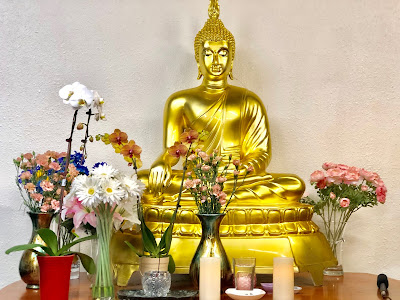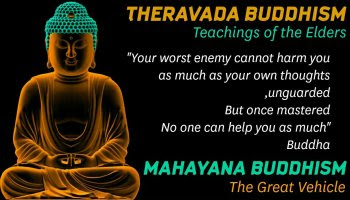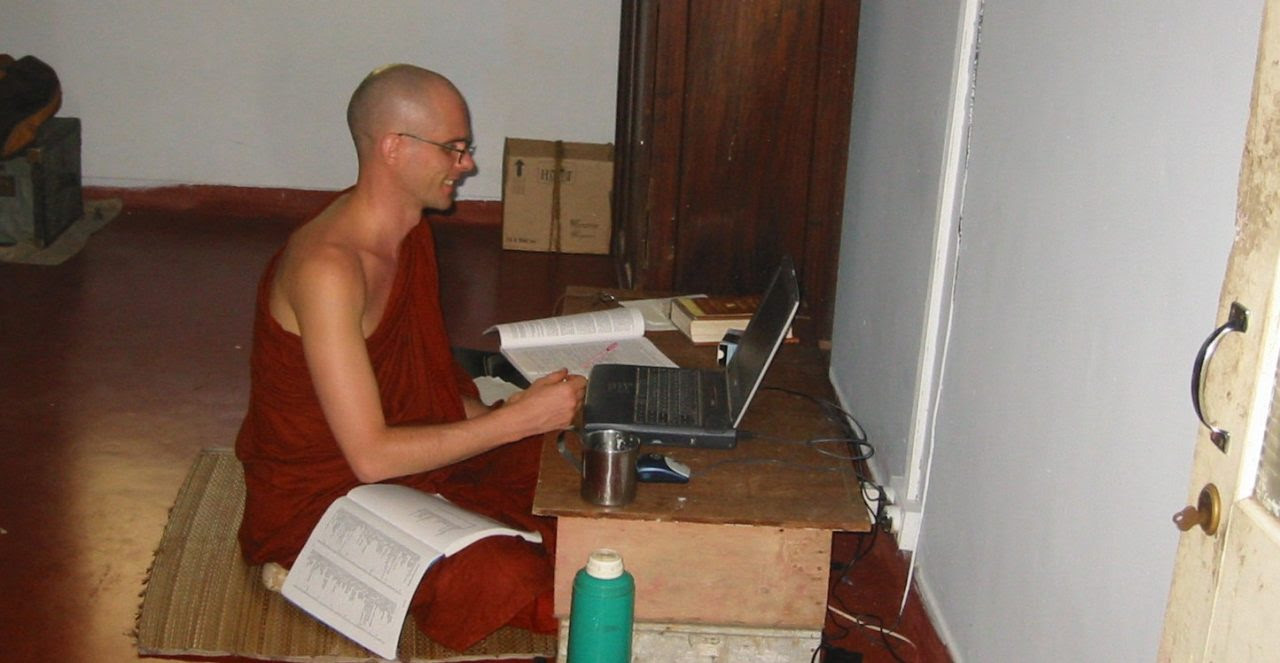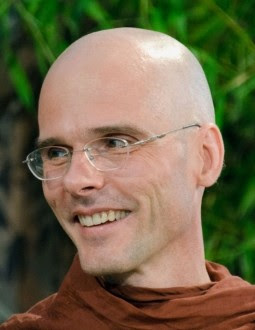I met German-born Analayo some years ago when he was
living a life of intensive meditation and study in a small retreat
centre in Sri Lanka. He told me how his study of the Buddha’s original
meditation teaching had led him to question established approaches to
practice.
Since then, he has published an acclaimed work on the
Satipatthana Sutta, the Buddha’s main teaching on mindfulness, taken
full Bhikkhu ordination, published many groundbreaking essays on Pali
Buddhism, especially comparisons between the Pali Suttas and the Chinese
versions, the Agamas and become a widely respected scholar and
academic. As this interview shows, he is above all a deeply devoted
Dharma practitioner
Vishvapani: How do you come to be living as a Buddhist monk here in Sri Lanka?
Analayo: I studied martial arts in Berlin and I found that the
discipline offered a way to express and contain my anger, but it didn’t
address the root of the problem. Along with martial arts I also learned
Soto Zen meditation, and when I found that through practising that some
of my anger no longer arose I became very interested in meditation. I
travelled to Asia and ended up in Thailand where I did a course in
mindfulness of breathing with Ajahn Buddhadasa. With Zen you are told to
just sit, but no more, and through Buddhadasa’s teaching I now received
some instruction in meditation.
Then came the start of the rainy season and the custom in Thailand is
for many people to become monks for the three months of the rains. So
that’s what I did, and I stayed in a cave on a hilltop, surrounded on
three sides by the sea, and there I had the opportunity to live a very
meditative life.
Once I was in robes I found that the monastic lifestyle supported
meditation so I decided to continue with it. Later I came to Sri Lanka
and stayed with Godwin Samaratane, who was an excellent meditation
teacher, and in 1995 he sent me to develop the Lewelle Meditation
Centre. Here we have a main house with a small community, and we’ve
built several kutis on the hill where I stay and other visitors can come
to meditate.
Godwin brought out aspects of meditation that are in the suttas [the
records of the Buddha’s discourses recorded in the Pali language] but
which have been neglected in Theravada tradition. He had a very
open-minded approach that emphasised emptiness, working constructively
with emotions, and developing metta (loving-kindness). He
wanted me to provide scholarly back-up for what he was doing, so he
introduced me to a university professor and the people at the university
just told me that I would be doing a PhD!
V: As a dedicated meditator, what was your motivation for engaging with academic study?
A: I wanted a better understanding of the Buddha’s teaching, and I
hoped to approach Buddhism both from the inside perspective of a
Buddhist monk and meditator, and also to look at it scientifically.
Being a meditating monk the most obvious topic was satipatthana, the development of mindfulness, and I found that there is almost no research on satipatthana or the Satipatthana Sutta, the principal canonical text concerning it.
The book I have eventually written is not only a vindication of
Godwin’s teaching, but also an attempt to go back to the roots and ask,
what were the Buddha’s basic ideas? What did he mean by insight
meditation? What is written in the Satipatthana Sutta, and how can other
suttas illuminate it?
The book reflects my particular perspective as both a scholar and a
practitioner. Academics sometimes go off at tangents because without
experience of practice they can get caught up in ideas that are a long
way from the original meanings. On the other hand meditation teachers
tend either to express their ideas and experience without going back to
the sources, or else to be steeped in the Theravada tradition. For
traditional Theravadins the suttas, which recount the Buddhas
discourses, and the commentaries, which were written later, are one
block. They see everything through the eyes of Buddhaghosha, the author
of the Visuddhimagga [the most important commentary] unaware
that there was an historical gap of 800 years between the Buddha and
Buddhaghosha. So I wanted to separate these out. The ideas and
techniques in the commentaries may well be good, but it’s important to
know that some weren’t taught by the Buddha.
V: How would you characterise the Buddha’s approach to meditation as it emerges from the discourses?
A: In the discourses when a monk comes to the Buddha and says he
wants to meditate, the Buddha usually just gives him a theme like,
‘don’t cling to anything.’ The monk goes off and when he returns he is
an arahant! [one with a high level of realisation]. In other
words, the Buddha gives the general pattern, not a precise technique
such as you find in the Visuddhimagga, whose approach we have
inherited. When the Buddha discusses concentration he talks about what
happens with the mind. He says that when pamojja (delight)
arises the mind naturally becomes joyful, and from that come happiness,
calm, tranquillity and concentration. So you should enjoy meditating,
and in enjoying itself the mind becomes unified.
At the same time the Buddha has a very clear, analytical approach,
and when he speaks of ‘the five hindrances’, for example, he is pointing
to specific experiences that imply specific antidotes. But that’s
different from issuing technical instructions. You could say that the
Buddha didn’t teach meditation so much as the skill of meditating or the
ability to meditate. He was concerned with stirring the natural
potential of individuals to awaken the mind on the basis of a very clear
distinction that never gets lost between what is wholesome in the mind
and what is unwholesome.
V: What difference does the distinction between commentarial
and sutta approaches to meditation make for what you do when you
meditate?
A: Being an ‘anger-type’ I thought it was important to develop metta. (loving-kindness). In Thailand I followed the Visuddhimagga approach of sending metta
to oneself, a friend, a neutral person and an enemy, and verbalising
good wishes. I found I got stuck in ideas, and when I turned to the
suttas I saw that the Buddha just says that, ‘with a mind full of metta’ (that is an attitude or feeling of loving-kindness) ‘he radiates metta
in all directions’. There’s no verbalisation, no particular people,
just this radiation. That made an incredible change in my practice and
from then on it evolved very strongly.
Another example is the counting methods in the commentarial approach
to the mindfulness of breathing, which are also not found in the suttas.
The Anapanasati Sutta
describes how in sixteen steps you can be aware of the breath, the
body, feelings, and what is happening in the mind. This extends to
seeing the impermanence of the breath.
This is an excellent approach to practice. Firstly, you calm the mind
by staying predominantly with bodily phenomena. Then you become aware
of your whole self as it sits in meditation, and then you notice how the
breath and the body become calmer. As soon as that happens thinking
activity also calms down, and joy arises. You’re aware of these changes
and encourage them, and that takes you away from the thinking activity
of the mind.
The commentarial approach implies narrowing the focus of attention
onto one point and only prescribes contemplating the most prominent
characteristics of the physical breath – not the many other dimensions
that are described in the sutta. Because you have so little material to
work on, the practice can become boring, so your mind wanders, and you
need counting as food for the mind. But counting can take you away from
the bodily experience of the breath to conceptual ideas about it.
However, if the mind has something it likes it will stay with it, and
that’s the way to get into deep concentration.
V: What about the importance of one-pointed concentration (ekagata), which is usually taught as the way to become fully absorbed?
A: Ekagata can also be translated as ‘unification of the
mind.’ So in developing meditative absorption it’s not so much that you
narrow everything down to a fine point. It’s more that everything
becomes ‘one’. If I take a large object and move it around you have no
trouble following it; but if you try to stay with a pin-point it’s very
difficult and that can create tension.
As you go deeper into meditation (in developing the higher states of meditative absorption known as jhana/dhyana) you need a reference point. But to enter jhana you have to let go of the five physical senses. So the experience of the breath becomes a mental equivalent of it (a nimitta)
not a felt experience. Sometimes meditators experience a light that is
an equivalent of the breath, which may envelop you entirely. Or the nimitta could be an experience of happiness or metta, or just mentally knowing the breath, and the mind becomes one with that.
An important term for meditative absorption is samadhi. We
often translate that as ‘concentration’, but that can suggest a certain
stiffness. Perhaps ‘unification’ is a better rendition, as samadhi means ‘to bring together’. Deep samadhi isn’t at all stiff. It’s a process of letting go of other things and coming to a unified experience.
V: I practice the five stages of the mettabhavana and I find that there’s a definite psychological value in that approach.
A: I’m not saying that the commentarial approach is wrong, only that
if it doesn’t work for you then there is an alternative. And whatever
practice you follow be aware if it comes from the Buddha or someone
else.
I know people who say the five-stage mettabhavana or the mindfulness
of breathing with counting works for them. That’s completely OK. I’m
trying to add to the commentarial view, and to broaden perspectives, not
to ask people to throw out the commentaries or their teacher’s
approach, and only listen to me. I have been practising the Goenka
technique for ten years and I got very good results with it. But I
wouldn’t say that it’s the only correct technique.
In the discourses the Buddha didn’t say that there’s one way for
everybody. In the Theravada tradition there have been many debates
about the relationship between samatha (absorption) and vipassana (insight) as goals of meditation. But the discourses say that you can practice samatha first, and then vipassana, or the other way around, or both together. Both samatha and vipassana develop the mind and the two co-operate, but how you engage with them depends on the individual.
V: The breadth of this approach implies knowing yourself sufficiently so that you can plot a course.
A: The process of developing insight is a matter of gaining
self-knowledge and learning to act accordingly. If you sit down to
meditate you need to feel the tendency of the mind – what it needs and
what it wants to do. More broadly, I know that my tendency is towards
anger and that means that I need to develop tranquillity to balance my
personality.
V: You place great emphasis on mindfulness, and also to have a very broad view of its implications.
A: The presentation of mindfulness in the discourses suggests an
open, receptive state of mind in which you let things come to you. It’s
different from concentration (samatha) in that concentration
means focus and mindfulness means breadth, but without mindfulness you
can’t develop concentration. It’s also an important basis for insight
meditation (vipassana). Mindfulness has many facets. Many
teachers speak of mindfulness of the body, but people don’t talk much
about the contemplations of feelings, mind and dhammas that are
also in the Satipatthana Sutta. But if you take any experience – like
sitting here now – you can be aware of the bodily aspect, how you feel
about what we are discussing; the state of mind that we are each in; and
you can see it in the light of the Buddha’s teachings. Each situation
has these four aspects and mindfulness can focus on one or all of these
as appropriate
V: How has studying these suttas affected your own meditation?
A: It’s the ground of my practice. Before I started my academic work I
decided that however many hours I studied I would spend more hours
meditating. That’s why it took me six years to complete my work. I would
never lose touch with my meditation practice for the sake of
theoretical study. On the other hand, though, a good knowledge of
Buddha’s teachings ‘clears the path’ as it enables you to know what
you’re doing and then you don’t experience doubt. Now I can learn from
various meditation teachers without getting confused because I know what
lines I am pursuing in my own practice.
The Buddha gave the talks that are recorded in the suttas because he
thought people should know what they are doing. Meditation is like
eating and the knowledge you have gained from the suttas is like the
digestive juice that makes it possible for your body to digest the
nutrients. The two belong together, but meditation has to have the
priority. Doing PhD research is perhaps going to an extreme. But
studying informed sources can be helpful for everyone. They can shine a
beam of light onto your practice and that can inspire it.
Ven. Analayo’s book on the Saitpatthana Sutta is Satipatthana: The Direct Path to Realization, Windhorse Publications, 2003.
The following excellent works are available as free online downloads.
They deserve to be much better known and make excellent study material
From Craving to Liberation, Excursions into the Thought-world of the Pali Discourses (1), Buddhist Association of the United States, 2009.Download PDF
From Grasping to Emptiness, Excursions into the Thought-world of the Pali Discourses (2), Buddhist Association of the United States, 2010.Download PDF
The Genesis of the Bodhisattva Ideal, Hamburg University Press, 2010.Download PDF
Bhikkhu Anālayo is a Privatdozent of the Centre for Buddhist Studies at the University of Hamburg and works as a researcher at Dharma Drum Buddhist College, Taiwan. He is also a professor at the Sri Lanka International Buddhist Academy, Kandy.
 Online Tipiṭaka Law Research & Practice University
in
112 CLASSICAL LANGUAGES
Online Tipiṭaka Law Research & Practice University
in
112 CLASSICAL LANGUAGES 















